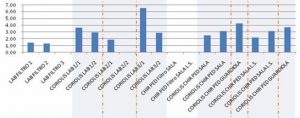Context
Latex products use have increased a lot over last 20 years with a considerable incidence on allergy to latex (single-use products). Latex sensitivity in the healthcare environment is an health problem, particularly, children poly-operated as Spina bifida patients and sanitary operators are concerned.
In this pilot study, we carried out the environmental monitoring of latex allergen in three different places in order to get quantitative data on airborne latex allergens in specific risky environments.
Materials
● Coriolis®μ, sterile cones, 15 ml of sterile collection liquid.
●Traditional method on PTFE filters (25 mm Ø – 1μm).
●ELISA tests (Indoor Biotechnologies).
Protocol
● Coriolis®μ: 2×20 min sampling for 3 days – 250 L/min – Quantification of liquid, sub-division, storage at -80°C.
● PTFE filters: 24 hours continuously sampling for three days -14 L/min – Allergen extraction overnight in PBS, centrifugation, sub-division, storage at -80°C.
● Specific ELISA tests for allergens: Hev b1, Hev b3, Hev b5, Hev b6.02.
Results
●The results for Hev b1 (ng/m3), Hev b5 and Hev b6.02 show the efficiency of the Coriolis air sampler to collect airborne latex allergens; Hev b1 results are illustrated in the graph for the three rooms and for both equipments.
(1- a room of our laboratory in full operation and use of latex gloves, 2- an operating pediatric surgery room during normal activities, 2’- during activities in latex safe conditions and 3- near nursery room).
Coriolis vs. PTFE positive data :
–Room 1: 5+/6 vs. 2+/3
–Room 2: 2+/2 vs. 0+/1
–Room 2’: 2+/2 vs. 0+/1
–Room 3: 2+/2


